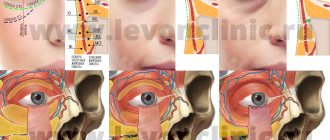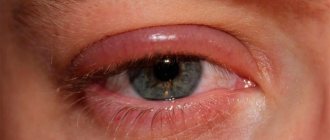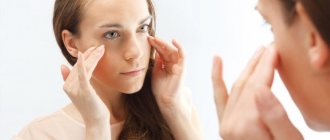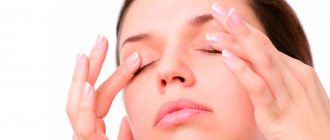How often have you encountered the unpleasant phenomenon of dark circles appearing under your eyes? Usually, women try to disguise this defect with cosmetics as quickly as possible and do not really think about the reason for its appearance. The effect is further enhanced by the fact that the eyes are located in the area of the orbital sockets and the manifestation of such shadows intensifies. To get rid of dark circles under the eyes, it is necessary to find out the reason for their appearance, since the methods for eliminating them depend on this.
Main causes
- Stress. General depression, chronic depression, attacks of causeless anxiety do not have the best effect on appearance.
- Physiology. In particular, heredity and age-related changes.
- Poor nutrition. The lack of the required amount of nutrients and minerals, an excess of fatty and fried foods are one of the main reasons for the formation of dark circles and many other skin problems.
- Schedule. Lack of proper sleep and negative factors during sleep (noise, bright light, lack of fresh air, etc.) can have an extremely negative impact on your overall appearance. Try to sleep at least 8 hours a day, provide access to fresh air.
- Bad habits. Alcohol and tobacco smoke contain substances that cause intoxication (poisoning) in the body. And your body will “tell” about this with the help of dark circles under the eyes and other skin manifestations.
- use of low-quality/incorrect cosmetics. The skin on the face is extremely sensitive and immediately reacts to irritants; if you cannot choose care products on your own, contact a specialist.
Diseases
Not always, swelling and bruising under the eyes are a sign of an unhealthy lifestyle. Often, the reason is the presence of certain diseases:
- Allergies. Accompanied by lacrimation, sneezing, redness of the eyes, difficulty breathing and coughing;
- Inflammation of the sinuses (sinusitis and sinusitis). They occur with painful sensations localized in the forehead and under the eyes, as well as copious discharge from the nose;
- Kidney diseases. When they occur, fluid retention occurs in the body, which causes not only swelling of the eyes, but also lower back pain and headaches;
- Diseases of the thyroid gland. Due to dysfunction of the thyroid gland, hormonal imbalance occurs - general weakness increases, body weight increases, the menstrual cycle changes, edema occurs;
- Heart failure. It is accompanied by shortness of breath and fatigue. Swelling and bruising under the eyes, almost invisible in the morning, appear in the late afternoon;
- Skin diseases - eczema and dermatitis.
How to get rid
Once the cause of the formation of dark circles is identified, it is necessary to take measures to get rid of them. We do not recommend self-medication. But there are several methods that will not harm your body:
- Drug treatment. It is prescribed when a patient has pathological diseases that require specific treatment. Often this may be related to the digestive organs or hormonal system.
- To refuse from bad habits. Smoking and alcohol negatively affect the general condition of the body and quitting them will help you avoid a large number of potential diseases.
- Active lifestyle. Running, morning exercises and just walking improve your blood circulation.
- Cosmetologist services. You can resort to the following procedures: mesotherapy, plasma lifting, biorevitalization and others that tone the vessels under the eyes.
- Using cosmetics or professional makeup.
- Hide. If you can’t get rid of the circles in the shortest possible time, you can simply disguise them. This task will be perfectly handled by: foundation, concealers and special creams that even out the skin color and nourish it. Choose a cream that contains vitamin C.
Preventing dark circles around the eyes
Cosmetologists advise paying attention to the following points:
- Good dream.
- Sufficient drinking regimen - at least 1.5 - 2 liters of liquid per day.
- The food is varied, with vitamins, minerals, proteins.
- Moisturizers for the care of the periorbital area.
- Treatment of chronic diseases of the kidneys, heart, veins, blood coagulation system.
- The body must receive enough oxygen, so it is useful to walk in the fresh air.
- You can periodically do lymphatic drainage facial massage.
- Do not smoke, do not abuse alcohol.
- Avoid prolonged sun exposure and apply skin care products with SPF.
sliders
To get a consultation
We will answer your questions
You can ask questions that interest you and get answers from competent specialists at our clinic.
Please contact us, we will be happy to help you!
To receive a free consultation, please use the special form.
Cyanosis (blueness of the skin)
Iron deficiency
24639 January 26
IMPORTANT!
The information in this section cannot be used for self-diagnosis and self-treatment.
In case of pain or other exacerbation of the disease, diagnostic tests should be prescribed only by the attending physician. To make a diagnosis and properly prescribe treatment, you should contact your doctor. Cyanosis: causes of appearance, what diseases it occurs with, diagnosis and treatment methods.
Definition
In many cases, the condition and color of the skin are an important diagnostic criterion for the doctor. Blueness of the skin (the medical term is cyanosis) indicates a lack of oxygen in the blood. Unfortunately, with the gradual development of cyanosis, a person and the people around him often do not notice a progressive change in skin tone, while the doctor is especially wary of cyanotic skin, which may indicate diseases of the vital organs of a person.
Types of cyanosis
Cyanosis is classified according to several parameters, each of which is important for the diagnostic search.
Depending on the prevalence of cyanotic coloration of the skin, total
cyanosis, characterized by a change in color of the entire surface of the skin, and
local
, localized in certain areas of the skin.
Local cyanosis may be central
and
peripheral
. Central cyanosis includes cyanosis of the oral mucosa (perioral cyanosis), nasolabial triangle, and area around the eyes (periorbital cyanosis). In addition, peripheral cyanosis, or acrocyanosis, is distinguished, which is characterized by a bluish coloration of the parts of the body most distant from the heart, located on the periphery - cyanosis of the fingers and toes, cyanosis of the earlobes, etc.
Depending on the speed of development, acutely emerging
cyanosis (rapidly progressing) and
chronic
cyanosis, which develops gradually and is present in a person for a long time.
Possible reasons for the development of cyanosis
The color of the skin is formed by two main factors: the presence of coloring pigments (for example, melanin) and the condition of the superficial blood vessels (the degree of opening of their lumen and the color of the blood in them).
The bluish tint of the skin is determined primarily by the color of the blood.
It is known that one of the most important functions of blood is the transfer of oxygen by attaching it to the protein hemoglobin, which is part of red blood cells.
Blood enriched with oxygen in the lungs is called arterial and has a scarlet tint.
As the cells of organs and tissues become saturated with oxygen, there is less oxygen in the blood and it takes on a cherry hue. Blood poor in oxygen is called venous. It is the accumulation of venous blood in the tissues that determines the characteristic bluish tint of the skin.
There are two main reasons for the accumulation of venous blood in tissues. The first reason is a circulatory disorder, in which the outflow of venous blood from the cells is disrupted. This mechanism underlies the development of cyanosis of the skin in diseases of the heart and blood vessels. The second reason is a violation of the enrichment of blood with oxygen in the lungs, which occurs with diseases of the respiratory system, with damage to the respiratory center (the functional structure of the brain and spinal cord that regulates the functioning of the respiratory muscles) or with a decrease in the concentration of oxygen in the air, for example at high altitudes.
What diseases cause cyanosis?
Cyanosis in most cases is a manifestation of pathology of the cardiovascular or respiratory systems.
Among heart diseases, it is worth noting a group of congenital heart defects, which are formed during the intrauterine development of the fetus and are manifested by cyanosis from infancy, and a group of acquired heart diseases, which includes a wide range of diseases leading to the development of heart failure. We list the main ones:
- Coronary heart disease, which includes, among others, angina pectoris and the consequences of myocardial infarction. The basis of this disease is insufficient oxygen supply to the heart muscle.
- Cardiomyopathies are primary lesions of cardiac muscle cells.
- Arrhythmias, such as atrial fibrillation.
- Infectious myocarditis is an inflammatory lesion of the heart muscle of infectious origin.
- Heart valve defects, such as aortic stenosis, mitral regurgitation, etc.
Among other diseases of the cardiovascular system, it is worth noting a violation of the patency of the peripheral veins, as a result of which there is a retention of venous blood in one or another segment of the body with the development of local cyanosis.
An example is chronic venous insufficiency of the lower extremities, in which varicose veins and a bluish discoloration of the skin of the feet and legs are observed.
Diseases of the respiratory system, often leading to the development of respiratory failure with the appearance of cyanosis, include:
- Pneumonia (pneumonia).
- Bronchiolitis (inflammation of the smallest bronchioles - the airways).
- Chronic obstructive pulmonary disease (COPD).
- Bronchial asthma, not controlled by taking special medications, and other rarer diseases.
It must be taken into account that the primary cause of circulatory and respiratory disorders can be explained by pathologies of other organs and systems, for example, endocrine glands, the central nervous system.
Which doctors should I contact if cyanosis develops?
Often, diseases of the circulatory and respiratory organs are treated jointly by several specialists. A therapist almost always appears among them. It is to him that you need to contact if a bluish tint of the skin appears. After the examination, the issue of referral to doctors of a narrow specialization is decided, for example, a cardiologist, pulmonologist (a doctor specializing in lung diseases), an allergist, an endocrinologist, a surgeon.
Diagnosis and examinations for cyanosis
The success of diagnosing the disease that led to the development of cyanosis largely depends on the conversation between the doctor and the patient and on the clinical examination. The patient needs to be told when cyanosis appeared, how intensively it developed, and on which parts of the body it manifested itself at first.
It is necessary to describe accompanying complaints, for example, cough, shortness of breath, interruptions in heart function, swelling, etc.
As a rule, acute cyanosis is accompanied by other significant manifestations, and it is these that serve as a reason to consult a doctor.
After the conversation, the doctor will examine the condition of the cardiovascular system, respiratory system and rule out damage to other organs. As a rule, already at this stage the doctor assumes one or another disease, the presence of which can be confirmed using laboratory and instrumental research methods:
- An exercise electrocardiogram can help diagnose heart disease and suggest lung disease.











